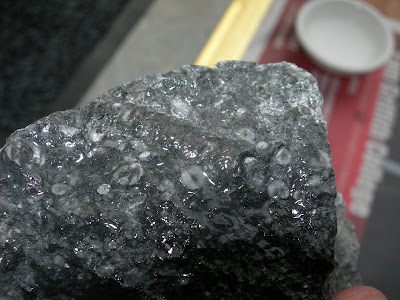Date 190210
Today we decided to go East. Two beaches we visited there, one in Ballybrannigan and the other in Garryvoe.
Ballybrannigan is near Cloyne, Co. Cork and is a really beautiful strand. We found brilliant specimens of crinoids and one particular coral species. We can see the segmented strands so maybe it could be a graptolite. In one rock I found the bryzoan, a little brachiopod and possilby a gastropod.
In Garyvoe, Ballycotton Bay we found another great crinoid specimen. Also we discovered a huge boulder covered in brachiopod fossils aswell as a few horn-coral fossils (Order Rugosa). Overall the day was a boon for fossils.
In Garryvoe we noticed that a lot of the limestone rocks were riddled with holes. These were caused by piddocks (Pholas dactylus). Pinn et al. 2005 note that these bivalves bore into the substratum and suggest that, because of this cryptic lifestyle, we know very little about their biology or ecology. However we do know that early naturalists were fascinated by their luminescence and boring ability. The luminescent properties even while being eaten was noted as early as AD77 by Pliny the Elder. And the Romans were reported to have eaten them. [Pinn et al. 2005 Burrow morphology, biometry, age and growth of piddocks (Mollusca: Bivalvia: Pholadidae) on the South coast of England Marine Biology 147 pp. 943-953].
See picture above of the piddock happily nestled in the rock (he's dead btw!).
Anyway, another great day for the 21st Century Naturalists.
Goodnight.


























 Found on mountain peaks penetrating the ice sheet in East Antarctica to the Chihuahuan desert Mexico, as well as the on moss growing stubbornly in your lawn (from which the specimen pictured was isolated), tardigrades are remarkable creatures. They have been exposed to -272.95°C for 20 hours, to 130°G, to 6,000 atmospheres of pressure, and to excessive concentrations of most common gases and x-rays, and were still able to return to active life.
Found on mountain peaks penetrating the ice sheet in East Antarctica to the Chihuahuan desert Mexico, as well as the on moss growing stubbornly in your lawn (from which the specimen pictured was isolated), tardigrades are remarkable creatures. They have been exposed to -272.95°C for 20 hours, to 130°G, to 6,000 atmospheres of pressure, and to excessive concentrations of most common gases and x-rays, and were still able to return to active life.




















